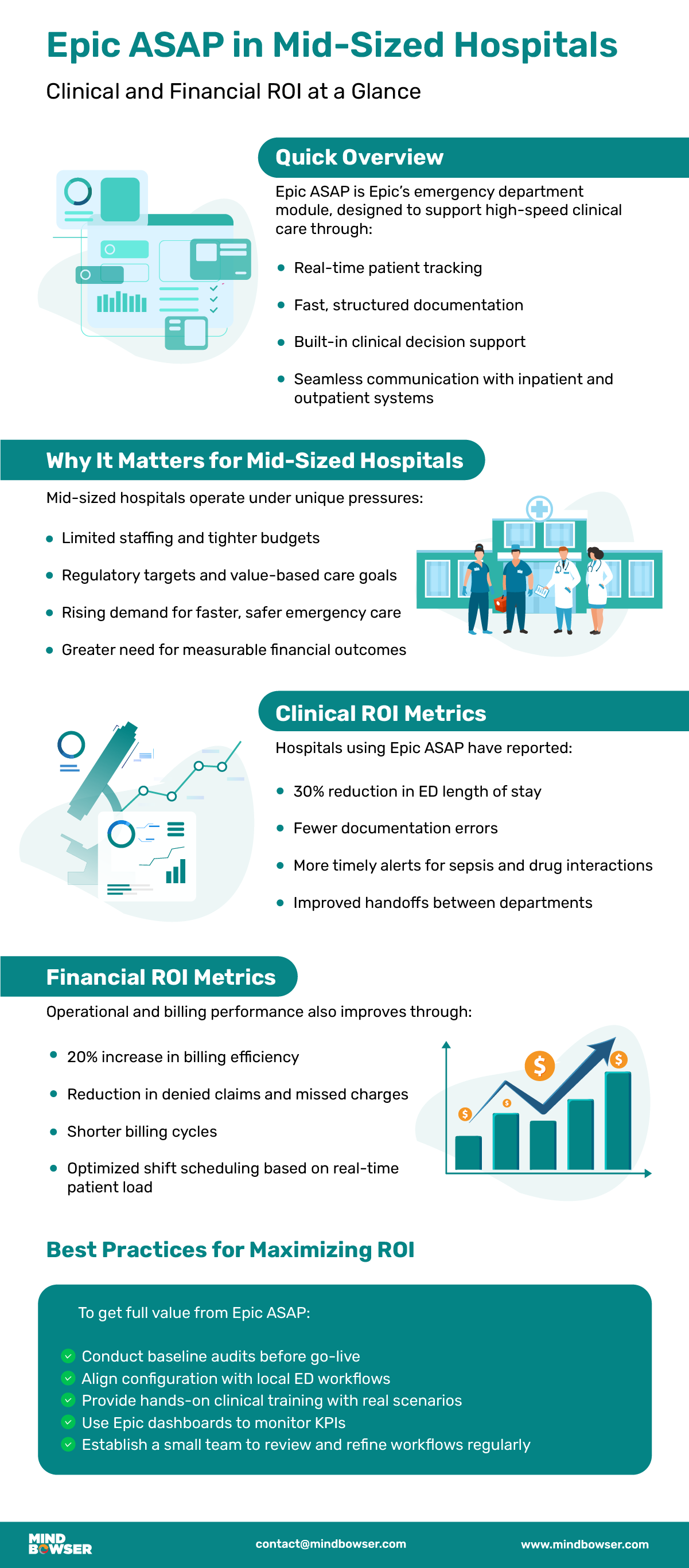Mid-sized hospitals today are walking a tightrope. On one side, they face the constant pressure to improve patient care, reduce wait times, and meet compliance standards. On the other hand, they need to make every dollar count, especially in emergency departments (EDs), where the demand is unpredictable and the costs are high. In this balancing act, technology plays a pivotal role, and Electronic Health Record (EHR) systems have become more than just digital filing cabinets. They’re tools for operational efficiency, clinical accuracy, and strategic growth—when implemented right.
Among the many EHR modules out there, Epic ASAP stands out as the go-to solution for emergency departments. It’s built to match the high-stakes, fast-moving nature of ED environments with real-time tracking, streamlined workflows, and integration that closes the gap between clinical care and hospital operations.
But hospitals—especially mid-sized ones—can’t afford to adopt software based on promise alone. They need proof. That’s where this conversation matters. This blog examines the clinical and financial return on investment (ROI) of implementing Epic ASAP in emergency departments, with a particular focus on how mid-sized hospitals can utilize it to reduce costs, enhance throughput, and enhance patient care. We’ll also highlight how Mindbowser helps hospitals maximize the benefits of their Epic integrations with tangible results.
Epic ASAP is Epic Systems’ dedicated module for emergency departments. Designed to meet the speed and complexity of ED environments, it delivers the tools frontline teams need to document efficiently, make informed decisions quickly, and keep patient care moving, without sacrificing accuracy or coordination.
At its core, Epic ASAP isn’t just a digital interface; it’s a clinical workflow engine built specifically for emergency settings. It integrates seamlessly into the broader Epic ecosystem, which enables smooth integration with inpatient and outpatient systems, pharmacy modules, and revenue cycle tools. That connection is critical, especially in mid-sized hospitals where silos can slow down care and cause revenue bottlenecks.
Here are a few key features that make Epic ASAP a strong fit for EDs:
For mid-sized hospitals, these features are more than conveniences; they’re critical to maintaining operational flow. With tighter budgets and leaner teams compared to large systems, every efficiency matters. Epic ASAP enables ED teams to work more efficiently without compromising care, a strategic advantage.
Learn how to showcase your app to thousands of Epic-integrated healthcare providers. From eligibility and API access to certification and launch, this guide walks you through every step to boost visibility, credibility, and adoption within the Epic ecosystem.
Emergency departments are among the busiest and most resource-intensive areas of any hospital. For mid-sized hospitals, the stakes are even higher. Unlike large academic centers, they often run with limited staff, tighter margins, and fewer buffer zones for inefficiency. In this environment, every delay, missed charge, or workflow breakdown adds up to both clinical risk and financial strain.
While emergency departments are vital to community health and hospital reputation, they can also be a financial sink if not managed well. Many EDs operate as cost centers, meaning they consume significant resources without a directly proportional return unless the right systems are in place. From walk-in traffic and ambulance arrivals to boarding delays and documentation gaps, it’s easy for throughput to slow down and revenue to leak.
The ED doesn’t function in isolation. When bottlenecks happen, whether in triage, diagnostics, or handoffs, they can ripple through the entire hospital. A delayed discharge from the ED may result in a delayed surgery in the OR or a patient being turned away from urgent care. This kind of inefficiency directly affects bed utilization, patient satisfaction scores, and even CMS reimbursements.
This is why understanding and measuring return on investment (ROI) from tools like Epic ASAP is not a luxury—it’s a necessity. Hospital administrators and clinical leaders need data-backed clarity on:
In our experience, when Epic ASAP is thoughtfully aligned with a hospital’s real workflows and goals, it often becomes more than just a documentation tool. It can evolve into a system that supports better patient care and stronger operational outcomes over time.
At Mindbowser, when we partner with mid-sized hospitals to integrate Epic ASAP, we focus on two outcomes: clinical gains and financial returns. The right setup—aligned to your real-world workflow—can unlock both. Our approach is grounded in clinical empathy, tech precision, and practical process engineering. Let’s break down the ROI drivers that matter most:
Delays at the front door of the ED have a cascading impact. With Epic ASAP, real-time dashboards that reflect patient status at every step—triage, labs, radiology, and discharge. This visibility reduces:
Fast and accurate documentation is at the heart of safe care and effective billing. Epic ASAP offers pre-built templates, auto-complete phrases, and structured note types based on your team’s workflows.
We also streamline clinical decision pathways by embedding hospital protocols, which reduces guesswork and improves care standardization—something that pays off in both outcomes and documentation quality.
Epic ASAP’s built-in alerts for sepsis, allergies, and drug interactions are powerful, but they work best when tailored to context.
This is where HealthCheck AI steps in. Our clinical workflow accelerator boosts early warning systems with population-specific triage models. It helps surface subtle signs of patient decline, making Epic alerts more actionable and reducing preventable escalations.
→ Ready to make your EHR alerts smarter? Ask us how HealthCheck AI fits into your Epic workflow.
We also support better transitions of care through customized ED-to-inpatient handoff checklists within the ASAP module.
Documentation drives revenue. The revenue cycle team ensures that ICD-10 and CPT coding flows are tightly integrated into ASAP workflows. With charge capture embedded at the point of care, we’ve helped hospitals:
We also flag common denial reasons during integration and build in early error detection into the documentation logic.
Every extra hour a patient spends in the ED reduces bed availability and drives up costs. By optimizing Epic ASAP workflows, such as order management, result routing, and discharge planning, hospitals can expedite patient movement without adding staff.
We’ve further strengthened this with our AI Length of Stay Predictor, a SMART on FHIR accelerator that forecasts LOS in real time using patient vitals, lab data, and historical patterns. This helps care teams prioritize discharges, avoid bottlenecks, and allocate resources efficiently.
Here’s what it enables:
Want to reduce average LOS with AI-driven decision support? Explore our LOS Predictor here.
Epic ASAP offers real-time visibility into staff utilization, patient acuity, and throughput patterns. At Mindbowser, we enhance this with a custom-built performance dashboard that overlays Epic data to highlight inefficiencies. Hospitals can quickly spot underutilized roles, workflow bottlenecks, and areas of missed savings, especially during peak hours.
Mid-sized hospitals often rely on hitting quality benchmarks tied to CMS incentives. We configure Epic ASAP to track key measures like
These benchmarks aren’t just numbers; they’re tied to federal reimbursement, star ratings, and accreditation. We ensure you’re measuring what matters in real time.

Understanding ROI from an Epic ASAP implementation isn’t just about software performance—it’s about what changes in the day-to-day realities of your emergency department. At Mindbowser, we guide our hospital partners through a metrics-first mindset, ensuring that clinical leaders, operations teams, and finance departments are aligned on what success looks like before and after go-live.
Here’s how we help measure the impact:
The most effective ROI assessments begin with baseline metrics. We establish a detailed “before” snapshot of ED performance, allowing gains to be measured. Common KPIs we track include:
Struggling with ER documentation delays and slow billing?
We helped a healthcare provider streamline their emergency room and rehab workflows by automating note structuring directly within Epic. The result?
Epic provides several built-in reporting tools that can be configured to monitor these metrics consistently:
What you measure is what gets managed. We help mid-sized hospitals establish executive dashboards that make ROI tangible for clinical, financial, and administrative teams. These tools also support board-level reporting, CMS attestation, and quality audits.
Whether it’s a reduction in LOS, a boost in collections, or a drop in claim denials, our goal is to make Epic ASAP’s impact visible, not just to IT, but to every stakeholder it touches.
While Epic ASAP has clear potential to drive both clinical and financial improvements, measuring ROI isn’t always straightforward, especially in mid-sized hospitals that juggle multiple priorities and operate with lean teams. Here are some of the common hurdles we help our clients navigate:
Even with a unified EHR like Epic, some hospitals still experience data silos. Lab results, inpatient handoffs, and follow-ups might be stored or coded differently, making it difficult to build a full picture of how ED changes affect downstream care.
Our approach: During integration, we audit data flows across departments and standardize documentation touchpoints that impact ROI tracking, such as disposition reasons, admission sources, and follow-up instructions.
Technology is only as good as its usage. If physicians and nurses don’t trust or understand new workflows, they revert to workarounds, and the ROI flatlines. Epic ASAP offers speed, but only when clinicians feel confident in using it efficiently.
Our approach: We support every go-live with tailored training modules, role-based workflow simulation, and live support for the first 30–60 days. We also collect user feedback early and often, applying it through iterative optimization cycles because fixing a small annoyance can unlock major time savings.
Training is most effective when it is tied to real clinical scenarios rather than just technical demonstrations. Physicians, nurses, and ancillary staff should have the opportunity to work with the system using examples that reflect their everyday responsibilities.
After the go-live phase, it is essential to establish a structured process for staff to report on what is working well and where they are encountering friction. This feedback should be collected regularly and used to make timely adjustments to templates, alerts, or workflows. Encouraging open communication builds trust in the system and supports continuous improvement.
Epic ASAP includes powerful tools such as Radar Dashboards, Flow Boards, and Cogito Analytics that can be used to monitor emergency department operations. These tools enable teams to track key metrics, including patient flow, documentation timeliness, staff workload, and quality measures.
However, these reports are only valuable if they are configured correctly and reviewed consistently. Hospitals should identify which reports align with their goals, customize the views for different user roles, and ensure department leaders are trained to interpret and act on the data.
Even a successful implementation can lose momentum if the system is not reviewed regularly. A cross-functional team comprising representatives from clinical, administrative, IT, and finance departments should be formed to oversee the continued optimization of Epic ASAP.
This committee should meet on a routine basis to review usage data, identify bottlenecks or usability issues, and prioritize enhancements. Whether it is refining an alert, updating documentation logic, or reconfiguring a workflow, ongoing adjustments ensure that the system continues to serve the evolving needs of the emergency department.
For Epic ASAP to truly deliver on its promise, mid-sized hospitals need to go beyond basic implementation. It is not just about installing a module but about weaving it thoughtfully into the day-to-day operations of the emergency department. Below are practical steps hospitals can take to ensure they see real and measurable returns from their investment.
Before configuring or deploying Epic ASAP, hospitals should take time to understand their current state. This involves identifying and documenting key performance indicators, such as average door-to-doctor time, patient wait times, length of stay in the emergency department, frequency of 72-hour revisit rates, and the time it takes to complete charts and submit bills.
Having this baseline allows hospital leaders to make meaningful comparisons after the system goes live. It also helps in setting realistic performance targets and aligning teams on what success looks like.
Emergency departments vary in their operations based on geography, patient volume, clinical staffing, and internal protocols. Therefore, it is crucial that Epic ASAP be customized to match the hospital’s specific workflows, rather than relying on default settings or templates from another facility.
Hospitals should take time to review their triage processes, documentation preferences, commonly used order sets, and care escalation patterns. Customizing the system to reflect these realities helps increase adoption, reduce confusion among staff, and ensure the system enhances rather than disrupts clinical care.
Training is most effective when it is tied to real clinical scenarios rather than just technical demonstrations. Physicians, nurses, and ancillary staff should have the opportunity to work with the system using examples that reflect their everyday responsibilities.
After the go-live phase, it is essential to establish a structured process for staff to report on what is working well and where they are encountering friction. This feedback should be collected regularly and used to make timely adjustments to templates, alerts, or workflows. Encouraging open communication builds trust in the system and supports continuous improvement.
Epic ASAP includes powerful tools such as Radar Dashboards, Flow Boards, and Cogito Analytics that can be used to monitor emergency department operations. These tools enable teams to track key metrics, including patient flow, documentation timeliness, staff workload, and quality measures.
However, these reports are only valuable if they are configured correctly and reviewed consistently. Hospitals should identify which reports align with their goals, customize the views for different user roles, and ensure department leaders are trained to interpret and act on the data.
Even a successful implementation can lose momentum if the system is not reviewed regularly. A cross-functional team comprising representatives from clinical, administrative, IT, and finance departments should be formed to oversee the continued optimization of Epic ASAP.
This committee should meet on a routine basis to review usage data, identify bottlenecks or usability issues, and prioritize enhancements. Whether it is refining an alert, updating documentation logic, or reconfiguring a workflow, ongoing adjustments ensure that the system continues to serve the evolving needs of the emergency department.
At Mindbowser, we work closely with hospitals and digital health companies to make Epic integrations more than just a technical milestone. Our focus is on enabling measurable clinical and financial outcomes, particularly in high-pressure environments such as the emergency department.
Healthcare providers can align Epic ASAP with real-world ED workflows, ensuring smoother triage, faster documentation, better resource management, and cleaner revenue cycles. Our team comprises specialists in Epic integration, healthcare analytics, and revenue cycle optimization who understand the daily challenges that mid-sized hospitals face.
Want to get more out of your Epic investment?
With workflows like HealthCheck AI, we help bring structure, clarity, and long-term value to every implementation. From reducing revisit rates to improving documentation accuracy and surfacing insights from operational data, we make sure your systems don’t just run, they deliver.
→ Ready to unlock the full potential of your Epic workflows? Let’s connect.
We don’t just integrate Epic. We help you make it work for your hospital—clinically, operationally, and financially.

For mid-sized hospitals, every technology decision comes with real financial and operational consequences. Emergency departments are high-volume, high-stakes environments where even small inefficiencies can add up quickly. That’s why choosing and implementing the right system is crucial, and measuring its impact is equally important.
Epic ASAP, when configured and utilized effectively, can transform the delivery of emergency care. It improves visibility, reduces bottlenecks, enhances documentation, and supports better outcomes for both patients and staff. However, the true return on investment extends beyond simply installing a system. It comes from aligning that system with your hospital’s workflows, tracking the right metrics, and committing to continuous improvement.
Hospitals that take this approach don’t just see faster throughput or cleaner claims. They see more satisfied clinicians, better patient outcomes, and a stronger bottom line.
If your organization is already using Epic or plans to optimize its emergency department operations, now is the time to consider not just implementation but also the long-term impact.
Epic ASAP is Epic’s dedicated module for emergency departments. It helps hospitals manage patient triage, documentation, tracking, clinical decision support, and communication across teams. The system is designed to streamline ED workflows, reduce delays, and support real-time care delivery in high-pressure environments.
Epic ASAP supports patient care by offering real-time visibility into patient status, timely clinical alerts, and structured documentation tools. These features reduce wait times, improve diagnostic accuracy, and ensure smoother transitions to inpatient care. With the right setup, it helps emergency teams work more efficiently and safely.
Hospitals can measure ROI by comparing pre- and post-implementation data across key performance indicators such as patient wait times, length of stay, chart completion rates, billing turnaround time, and coding accuracy. Tools like Epic’s Radar and Cogito, along with custom dashboards, can provide the necessary visibility to track improvements in clinical and financial performance.

We worked with Mindbowser on a design sprint, and their team did an awesome job. They really helped us shape the look and feel of our web app and gave us a clean, thoughtful design that our build team could...


The team at Mindbowser was highly professional, patient, and collaborative throughout our engagement. They struck the right balance between offering guidance and taking direction, which made the development process smooth. Although our project wasn’t related to healthcare, we clearly benefited...

Founder, Texas Ranch Security

Mindbowser played a crucial role in helping us bring everything together into a unified, cohesive product. Their commitment to industry-standard coding practices made an enormous difference, allowing developers to seamlessly transition in and out of the project without any confusion....

CEO, MarketsAI

I'm thrilled to be partnering with Mindbowser on our journey with TravelRite. The collaboration has been exceptional, and I’m truly grateful for the dedication and expertise the team has brought to the development process. Their commitment to our mission is...

Founder & CEO, TravelRite

The Mindbowser team's professionalism consistently impressed me. Their commitment to quality shone through in every aspect of the project. They truly went the extra mile, ensuring they understood our needs perfectly and were always willing to invest the time to...

CTO, New Day Therapeutics

I collaborated with Mindbowser for several years on a complex SaaS platform project. They took over a partially completed project and successfully transformed it into a fully functional and robust platform. Throughout the entire process, the quality of their work...

President, E.B. Carlson

Mindbowser and team are professional, talented and very responsive. They got us through a challenging situation with our IOT product successfully. They will be our go to dev team going forward.

Founder, Cascada

Amazing team to work with. Very responsive and very skilled in both front and backend engineering. Looking forward to our next project together.

Co-Founder, Emerge

The team is great to work with. Very professional, on task, and efficient.

Founder, PeriopMD

I can not express enough how pleased we are with the whole team. From the first call and meeting, they took our vision and ran with it. Communication was easy and everyone was flexible to our schedule. I’m excited to...

Founder, Seeke

We had very close go live timeline and Mindbowser team got us live a month before.

CEO, BuyNow WorldWide

Mindbowser brought in a team of skilled developers who were easy to work with and deeply committed to the project. If you're looking for reliable, high-quality development support, I’d absolutely recommend them.

Founder, Teach Reach

Mindbowser built both iOS and Android apps for Mindworks, that have stood the test of time. 5 years later they still function quite beautifully. Their team always met their objectives and I'm very happy with the end result. Thank you!

Founder, Mindworks

Mindbowser has delivered a much better quality product than our previous tech vendors. Our product is stable and passed Well Architected Framework Review from AWS.

CEO, PurpleAnt

I am happy to share that we got USD 10k in cloud credits courtesy of our friends at Mindbowser. Thank you Pravin and Ayush, this means a lot to us.

CTO, Shortlist

Mindbowser is one of the reasons that our app is successful. These guys have been a great team.

Founder & CEO, MangoMirror

Kudos for all your hard work and diligence on the Telehealth platform project. You made it possible.

CEO, ThriveHealth

Mindbowser helped us build an awesome iOS app to bring balance to people’s lives.

CEO, SMILINGMIND

They were a very responsive team! Extremely easy to communicate and work with!

Founder & CEO, TotTech

We’ve had very little-to-no hiccups at all—it’s been a really pleasurable experience.

Co-Founder, TEAM8s

Mindbowser was very helpful with explaining the development process and started quickly on the project.

Executive Director of Product Development, Innovation Lab

The greatest benefit we got from Mindbowser is the expertise. Their team has developed apps in all different industries with all types of social proofs.

Co-Founder, Vesica

Mindbowser is professional, efficient and thorough.

Consultant, XPRIZE

Very committed, they create beautiful apps and are very benevolent. They have brilliant Ideas.

Founder, S.T.A.R.S of Wellness

Mindbowser was great; they listened to us a lot and helped us hone in on the actual idea of the app. They had put together fantastic wireframes for us.

Co-Founder, Flat Earth

Mindbowser was incredibly responsive and understood exactly what I needed. They matched me with the perfect team member who not only grasped my vision but executed it flawlessly. The entire experience felt collaborative, efficient, and truly aligned with my goals.

Founder, Child Life On Call

The team from Mindbowser stayed on task, asked the right questions, and completed the required tasks in a timely fashion! Strong work team!

CEO, SDOH2Health LLC

Mindbowser was easy to work with and hit the ground running, immediately feeling like part of our team.

CEO, Stealth Startup

Mindbowser was an excellent partner in developing my fitness app. They were patient, attentive, & understood my business needs. The end product exceeded my expectations. Thrilled to share it globally.

Owner, Phalanx

Mindbowser's expertise in tech, process & mobile development made them our choice for our app. The team was dedicated to the process & delivered high-quality features on time. They also gave valuable industry advice. Highly recommend them for app development...

Co-Founder, Fox&Fork
